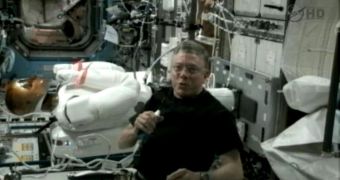Yesterday, August 22, the Expedition 28 crew aboard the International Space Station (ISS) powered up their newest crewmember, Robonaut 2. This is a robotic astronauts designed to assist the astronauts with some of the most perilous and complex tasks on the orbital facility.
The machine was launched to the ISS on February 24, aboard the space shuttle Discovery. The STS-133 mission was the orbiter's final flight. Since that time, the station crew did not have sufficient time on their hands to go through the necessary procedures for activating their companion.
These past few months have seen a flurry of activity on the orbital outpost, with numerous experiments being conducted at the same time. Additionally, two more shuttles visited the station on their final, respective flights, which further increased astronauts' workloads.
Now, nearly 6 months later, everything was set for powering up the robotic assistant's systems. After the initial procedure, crewmembers began conducting tests to see how Robonaut 2's power systems and onboard cameras were doing.
“Those electrons feel GOOD! One small step for man, one giant leap for tinman kind. Sure wish I could move my head and look around,” posts on Robonaut 2's Twitter page read yesterday.
According to NASA, the machine will remain in its fixed position for several more weeks, as the crew continues to run additional tests on all primary and secondary systems. Once everything is deemed to be in order, the machine will finally be restored to its full glory.
“He has been groveling in his stowage location over here in the lab. The complaint's mainly been that he wants to get out and get to work. Well, today is finally the day,” ISS flight engineer and NASA astronaut Mike Fossum radioed to Mission Control yesterday.
Ultimately, the goal is to have the robot assist his human counterparts during spacewalk, applying both smooth and rough touches where they are needed. Once the crew and robot learn to work together, NASA expects to make chores aboard the ISS easier to perform than ever.
At first, Robonaut 2 will remain inside the American-built Destiny module, but it will later be taken outside the ISS. A second machine of the same type is currently being prepared for tests here on Earth.
The machine will participate in the DeserRATS competition, which will be held in the Arizona desert. NASA affixes the robot to a wheel base, and allows it to roam around, demonstrating new space exploration technologies.
In the long term, such machines could be used to help settlers on other worlds collect raw materials, construct buildings, and perform other vital chores, Space reports.

 14 DAY TRIAL //
14 DAY TRIAL //